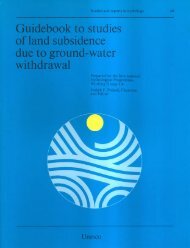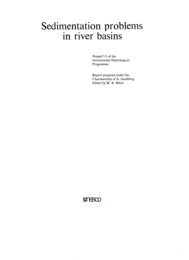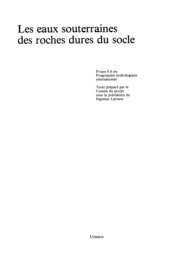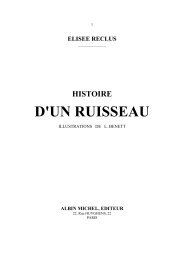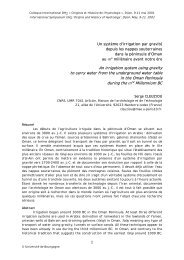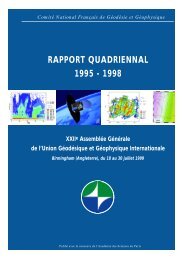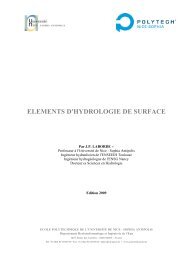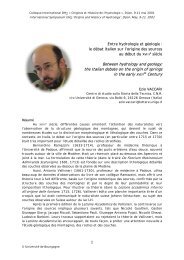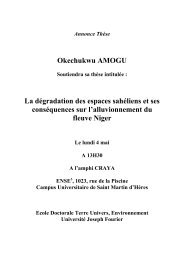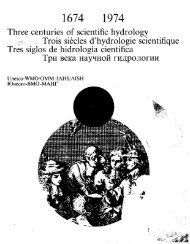- Page 5 and 6: TABLE DES MATIÈRES Résumé i Abst
- Page 7 and 8: TABLE DES MATIÈRES 2.4 Analyse du
- Page 9 and 10: TABLE DES FIGURES 1 Planisphère et
- Page 11 and 12: TABLE DES FIGURES 1.31 Coupes géol
- Page 13 and 14: TABLE DES FIGURES 2.24 Localisation
- Page 15 and 16: TABLE DES FIGURES B.4 Répartition
- Page 17 and 18: LISTE DES TABLEAUX 3.1 Table prése
- Page 19: RÉSUMÉ Sur la côte du Nord Chili
- Page 24 and 25: vi Fig. 1 - Carte du monde (donnée
- Page 26 and 27: Fig. 3 - Schémas synthétiques des
- Page 28 and 29: Fig. 5 - Exemples de modèles propo
- Page 30 and 31: Au Nord Chili, le système de cheva
- Page 32 and 33: Cette thèse a pour objectif de ré
- Page 34 and 35: sultats présentés dans ce travail
- Page 36 and 37: 1.1 Introduction 1 000 km de long,
- Page 38 and 39: 1.1 Introduction A la latitude de S
- Page 40 and 41: 1.1 Introduction un abrupt topograp
- Page 42 and 43: 1.2 Le Bloc Marginal de la marge de
- Page 44 and 45: 1.2 Le Bloc Marginal de la marge de
- Page 46 and 47: 1.2 Le Bloc Marginal de la marge de
- Page 48 and 49: 1.2 Le Bloc Marginal de la marge de
- Page 50 and 51: 1.2 Le Bloc Marginal de la marge de
- Page 52 and 53: 1.2 Le Bloc Marginal de la marge de
- Page 54 and 55: 1.2 Le Bloc Marginal de la marge de
- Page 56 and 57: 1.2 Le Bloc Marginal de la marge de
- Page 58 and 59: 1.2 Le Bloc Marginal de la marge de
- Page 60 and 61: 1.2 Le Bloc Marginal de la marge de
- Page 62 and 63: 1.2 Le Bloc Marginal de la marge de
- Page 64 and 65: 1.2 Le Bloc Marginal de la marge de
- Page 66 and 67: 1.2 Le Bloc Marginal de la marge de
- Page 68 and 69: 1.2 Le Bloc Marginal de la marge de
- Page 70 and 71:
1.2 Le Bloc Marginal de la marge de
- Page 72 and 73:
1.2 Le Bloc Marginal de la marge de
- Page 74 and 75:
1.2 Le Bloc Marginal de la marge de
- Page 76 and 77:
1.2 Le Bloc Marginal de la marge de
- Page 78 and 79:
1.2 Le Bloc Marginal de la marge de
- Page 80 and 81:
1.2 Le Bloc Marginal de la marge de
- Page 82 and 83:
1.2 Le Bloc Marginal de la marge de
- Page 84 and 85:
1.2 Le Bloc Marginal de la marge de
- Page 86 and 87:
1.2 Le Bloc Marginal de la marge de
- Page 88 and 89:
1.2 Le Bloc Marginal de la marge de
- Page 90 and 91:
1.2 Le Bloc Marginal de la marge de
- Page 92 and 93:
1.2 Le Bloc Marginal de la marge de
- Page 94 and 95:
1.3 Les marqueurs d’une déformat
- Page 96 and 97:
1.3 Les marqueurs d’une déformat
- Page 98 and 99:
1.3 Les marqueurs d’une déformat
- Page 100 and 101:
1.3 Les marqueurs d’une déformat
- Page 102 and 103:
1.3 Les marqueurs d’une déformat
- Page 104 and 105:
1.3 Les marqueurs d’une déformat
- Page 106 and 107:
1.3 Les marqueurs d’une déformat
- Page 108 and 109:
1.3 Les marqueurs d’une déformat
- Page 110 and 111:
1.3 Les marqueurs d’une déformat
- Page 112 and 113:
1.3 Les marqueurs d’une déformat
- Page 114 and 115:
1.4 Déformation côtière récente
- Page 116 and 117:
1.4 Déformation côtière récente
- Page 118 and 119:
1.4 Déformation côtière récente
- Page 120 and 121:
1.4 Déformation côtière récente
- Page 122 and 123:
1.5 Synthèse 1.5 Synthèse La Fig.
- Page 124 and 125:
1.5 Synthèse Cette étude bibliogr
- Page 126 and 127:
2.2 Conditions paléo-climatiques d
- Page 128 and 129:
2.2 Conditions paléo-climatiques d
- Page 130 and 131:
2.2 Conditions paléo-climatiques d
- Page 132 and 133:
2.3 Analyse morphologique 3D du Blo
- Page 134 and 135:
2.3 Analyse morphologique 3D du Blo
- Page 136 and 137:
2.3 Analyse morphologique 3D du Blo
- Page 138 and 139:
2.3 Analyse morphologique 3D du Blo
- Page 140 and 141:
2.3 Analyse morphologique 3D du Blo
- Page 142 and 143:
2.3 Analyse morphologique 3D du Blo
- Page 144 and 145:
2.3 Analyse morphologique 3D du Blo
- Page 146 and 147:
2.3 Analyse morphologique 3D du Blo
- Page 148 and 149:
2.4 Analyse du système de drainage
- Page 150 and 151:
2.4 Analyse du système de drainage
- Page 152 and 153:
2.4 Analyse du système de drainage
- Page 154 and 155:
2.4 Analyse du système de drainage
- Page 156 and 157:
2.5 Caractérisation d’une défor
- Page 158 and 159:
2.5 Caractérisation d’une défor
- Page 160 and 161:
2.5 Caractérisation d’une défor
- Page 162 and 163:
2.5 Caractérisation d’une défor
- Page 164 and 165:
2.5 Caractérisation d’une défor
- Page 166 and 167:
2.6 Conclusions grande échelle de
- Page 168 and 169:
2.6 Conclusions Fig. 2.26 - Evoluti
- Page 170 and 171:
3.1 Introduction Fig. 3.1 - (Haut)
- Page 172 and 173:
3.1 Introduction Bolivien (Garreaud
- Page 174 and 175:
3.1 Introduction Le gradient des ta
- Page 176 and 177:
3.2 Conditions aux limites des mod
- Page 178 and 179:
3.3 Résultats des modélisations 3
- Page 180 and 181:
3.3 Résultats des modélisations L
- Page 182 and 183:
3.3 Résultats des modélisations p
- Page 184 and 185:
3.4 Comparaison aux réseaux du Nor
- Page 186 and 187:
3.5 Limitations des conditions exp
- Page 188 and 189:
3.5 Limitations des conditions exp
- Page 190 and 191:
3.6 Âge et mode d’incision à 19
- Page 192 and 193:
3.6 Âge et mode d’incision Fig.
- Page 194 and 195:
3.7 Conclusions Fig. 3.12 - Influen
- Page 196 and 197:
3.8 Annexes 3.8 Annexes 3.8.1 Princ
- Page 198 and 199:
3.8 Annexes de diffusion κbr pour
- Page 200 and 201:
3.8 Annexes Tab. 3.2 - Table prése
- Page 202 and 203:
3.8 Annexes Tab. 3.4 - Table prése
- Page 204 and 205:
3.8 Annexes étendue pour l’expé
- Page 206 and 207:
3.8 Annexes Fig. 3.13 - Influence d
- Page 208 and 209:
3.8 Annexes Fig. 3.14 - Influence d
- Page 210 and 211:
3.8 Annexes Fig. 3.16 - Influence d
- Page 212 and 213:
3.8 Annexes Fig. 3.18 - Influence d
- Page 214 and 215:
3.8 Annexes Fig. 3.20 - Influence d
- Page 216 and 217:
182
- Page 218 and 219:
située à 1 000 m d’altitude et
- Page 220 and 221:
186 Fig. I - Coupe géologique à g
- Page 222 and 223:
Fig. II - Principales zones de déf
- Page 224 and 225:
tensité des précipitations dans l
- Page 226 and 227:
l’augmentation des précipitation
- Page 228 and 229:
et Février. Les cartes présentée
- Page 230 and 231:
196 Fig. B.4 - (Gauche) Taux de pr
- Page 232 and 233:
Fig. C.1 - Plateaux artificiels int
- Page 234 and 235:
La Fig.C.2.a présente une comparai
- Page 236 and 237:
Fig. C.3 - Tableau des paramètres
- Page 238 and 239:
Fig. C.5 - "Faux" knickpoint dû à
- Page 240 and 241:
Tab. D.2 - Table des âges estimés
- Page 242 and 243:
208
- Page 244 and 245:
210
- Page 246 and 247:
active tectonics along the Coastal
- Page 248 and 249:
Dewey, J. F., and J. M. Bird (1970)
- Page 250 and 251:
Jordan, T., P. Nester, N. Blanco, G
- Page 252 and 253:
from neogene paleosol and geomorpho
- Page 254 and 255:
SERNAGEOMIN (2003), Mapa Geologico
- Page 256 and 257:
Montpellier, le 27 Janvier 2012 Rap
- Page 258 and 259:
sont combinées à une modélisatio
- Page 260 and 261:
de terrain. Ce travail aboutit en p
- Page 262 and 263:
COUDURIER CURVEUR Aurélie Section
- Page 264 and 265:
E-MAIL acoudurierc@gmail.com HOMEPA



